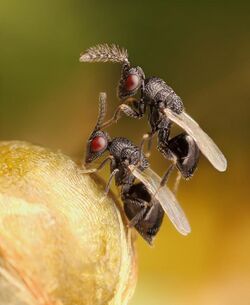Biology:Eurytomidae
| Eurytomidae | |
|---|---|

| |
| Scientific classification | |
| Domain: | Eukaryota |
| Kingdom: | Animalia |
| Phylum: | Arthropoda |
| Class: | Insecta |
| Order: | Hymenoptera |
| Superfamily: | Chalcidoidea |
| Family: | Eurytomidae Walker, 1832 |
| Subfamilies | |
|
Buresiinae | |
| Diversity | |
| Four subfamilies c.85 genera c.1420 species | |
The Eurytomidae are a family within the superfamily Chalcidoidea.
Unlike most chalcidoids, the larvae of many are phytophagous (feeding in stems, seeds, or galls), while others are more typical parasitoids, though even then the hosts are usually found within plant tissues. Some species of eurytomids are unusual in the sense that they are parasitoids of spider eggs. Females of this group are idiobionts that probe through the thin silk of spider egg sacs and oviposit into individual spider eggs that are clustered within the sacs. [1]
They are found throughout the world in virtually all habitats, and a few are considered pests.
They tend to be dull and not metallic, and heavily punctured, with very thick, collar-like pronota.
Taxa
(As of 2021), Eurytomid genera include:[2]
Buresiinae Lotfalizadeh et al., 2007[3]
- Buresium Boucek, 1969
- Macrorileya Ashmead, 1900
Eurytominae Walker, 1832
- Aiolomorphus Walker, 1871
- Aranedra Burks, 1971
- Austrodecatoma Girault, 1925
- Ausystole Boucek, 1988
- Axanthosoma Girault, 1913
- Axanthosomella Narendran, 2001
- Axima Walker, 1862
- Aximopsis Ashmead, 1904
- Banyoma Burks, 1971
- Bephrata Cameron, 1884
- Bephratelloides Girault, 1913
- Bephratoides Brues, 1909
- Bruchodape Burks, 1971
- Bruchophagus Ashmead, 1888
- Burksoma Subba Rao, 1978
- Camponotophilus Gates, 2012
- Cathilaria Burks, 1971
- Chryseida Spinola, 1840
- Chryseurytoma Chen & Huang, 2004
- Endobia Erdos, 1964
- Eudoxinna Walker, 1864
- Eurytoma Illiger, 1807
- Eurytomocharis Ashmead, 1888
- Exeurytoma Burks, 1971
- Ficomila Boucek, 1981
- Foutsia Burks, 1971
- Fronsoma Narendran, 1994
- Gibsonoma Narendran, 1994
- Giraultoma Boucek, 1988
- Heimbrella Subba Rao, 1978
- Hexeurytoma Dodd, 1917
- Homodecatoma Liao, 1979
- Houstonia Boucek, 1988
- Isosomodes Ashmead, 1888
- Kavayva Zhang, Gates, & Silvestre 2021
- Khamul Gates, 2008
- Mangoma SubbaRao, 1986
- Masneroma Boucek, 1983
- Neobephrata Narendran & Padmasenan, 1989
- Parabruchophagus Zerova, 1992
- Paradecatoma Masi, 1943
- Philippinoma Narendran, 1994
- Philolema Cameron, 1908
- Phleudecatoma Yang, 1996
- Phylloxeroxenus Ashmead, 1888
- Plutarchia Girault, 1925
- Prodecatoma Ashmead, 1904
- Prodecatomidea Risbec, 1952
- Proseurytoma Kieffer, 1910
- Pseudotetramesa Kalina, 1970
- Ramanuja Narendran, 1989
- Ramdasoma Narendran, 1994
- Risbecoma SubbaRao, 1978
- Stigmeurytoma Boucek, 1988
- Syceurytoma Boucek, 1981
- Sycophila Walker, 1871
- Systole Walker, 1832
- Systolema Narendran, 1994
- Tenuipetiolus Bugbee, 1951
- Tetramesa Walker, 1848
- Tetramesella Zerova, 1974
- Townesoma Narendran, 1994
- Zerovella Narendran & Sheela, 1994
Heimbrinae Burks, 1971
- Heimbra Cameron, 1909
- Symbra Stage & Snelling, 1986
Rileyinae Ashmead, 1904
- Austrophotismus Girault, 1938
- Boucekiana De Santis, 1975
- Dougiola Boucek, 1988
- Gatesina Pujade-Villar et al., 2018
- Neorileya Ashmead, 1904
- Platyrileya Burks, 1971
- Rileya Ashmead, 1888
References
- ↑ Fei, Minghui; Gols, Rieta; Harvey, Jeffrey A. (2023-01-23). "The Biology and Ecology of Parasitoid Wasps of Predatory Arthropods". Annual Review of Entomology 68 (1): 109–128. doi:10.1146/annurev-ento-120120-111607. ISSN 0066-4170. PMID 36198401. http://dx.doi.org/10.1146/annurev-ento-120120-111607.
- ↑ Noyes, J. S. (March 2019). "Universal Chalcidoidea Database". http://www.nhm.ac.uk/chalcidoids.
- ↑ LOTFALIZADEH, HOSSEINALI; DELVARE, GÉRARD; RASPLUS, JEAN-YVES (November 2007). "Phylogenetic analysis of Eurytominae (Chalcidoidea: Eurytomidae) based on morphological characters". Zoological Journal of the Linnean Society 151 (3): 441–510. doi:10.1111/j.1096-3642.2007.00308.x. ISSN 1096-3642.
External links
- Universal Chalcidoidea Database
- Cedar Creek Pinned specimen images.
- Philolema latrodecti (Fullaway) on the UF / IFAS Featured Creatures Web site
- Bugguide.net. Family Eurytomidae
Wikidata ☰ Q1948642 entry
 |


